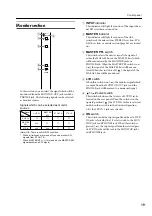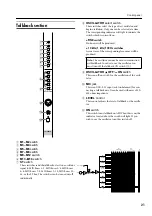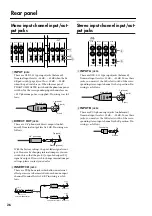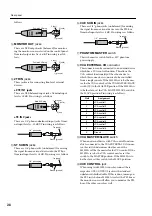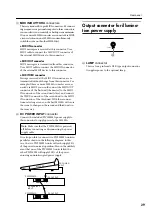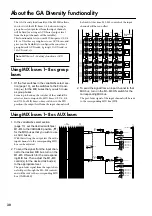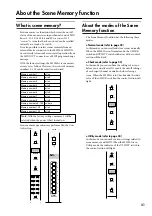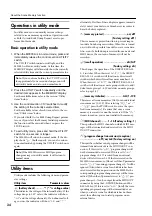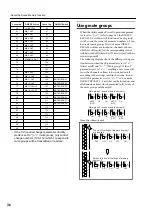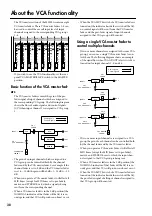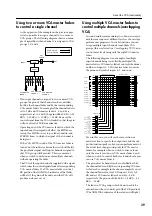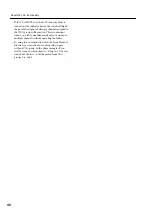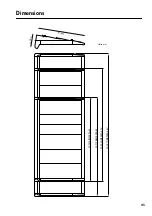
About the Scene Memory function
32
Operations in normal mode
Storing a scene (normal mode)
1. Make sure that the M3000A is in normal mode,
and use the ON/EDIT switches of the mono/ste-
reo input channels, the mix section and the STE-
REO A section to make the desired on/off
settings.
2. Use the control section
▲
/
▼
switches or the 0–9/
ENTER buttons of the control section to make
the MEMORY display indicate the memory num-
ber (1–128) into which you wish to store the
scene. (Memory numbers 129/130 are read-only,
and cannot be selected.)
The selected memory number will blink in the MEM-
ORY display. Scenes which are stored in memory
numbers 1–8 can be selected at one touch using the
DIRECT RECALL 1–8 switches. If you need one-
touch access to a scene memory, it is convenient to
store it in one of these memory numbers.
3. Press the STORE switch.
The MEMORY display will blink “
,” indicating
that the M3000A is ready to store the scene.
4. To execute the Store operation, press the
STORE switch once again.
If you decide not to store, you can cancel the opera-
tion by pressing any switch other than STORE.
Recalling a scene (normal mode)
1. Use the control section
▲
/
▼
switches or the 0–9/
ENTER buttons of the control section to make
the MEMORY display indicate the memory num-
ber (1–130) that you wish to recall.
The selected memory number will blink. Read-only
memory numbers 129/130 can be selected only by the
0–9/ENTER buttons. When a mute group is being
used, memory numbers 1-8 can be selected only by
the 0-9/ENTER buttons.
2. Press the RECALL switch.
The selected scene memory will be recalled.
3. To instantly recall a memory number 1–8, press
the desired DIRECT RECALL 1–8 switch.
With the factory settings, the scenes of memory num-
bers 1–8 can be recalled directly by the DIRECT
RECALL 1–8 switches. (This is referred to as “direct
recall.”) In this case, it is not necessary to press the
RECALL switch, and the scene will change instantly.
If you press the
▲
/
▼
switches following a direct recall
operation, the scene memory number which had been
selected before you pressed the DIRECT RECALL 1–8
switch will blink in the display. This allows you to
quickly return to the previous scene number even if
you used direct recall while selecting consecutive
scene memories.
Note:
In normal mode, operation of all ON/EDIT
switches will affect the signal which is actually out-
put. If you are conducting a rehearsal or actual per-
formance and wish to make on/off settings without
affecting the signals that are being output, use
Check mode.
Note:
When you perform the Store operation, the
contents that were previously in that memory num-
ber will be erased, and cannot be recovered. Be
aware of this as you select of a store destination.
Note:
If memory protect is on, the MEMORY dis-
play will indicate “
,” and it will not be possible
to execute the Store operation. Disable memory
protect, and execute the Store operation once again.
(For details on disabling memory protect, refer to
page 34.)
Note:
STEREO B OUT is not affected by scene
memories.
Note:
If no data has been stored in the selected
scene, the MEMORY display will indicate “
,”
and the scene will not be recalled.
Note:
The DIRECT RECALL 1–8 switches can also
be used as mute group switches to add/defeat mute
groups. If they are being used as mute group
switches, the DIRECT RECALL function will be
disabled. For details, refer to page 36.


